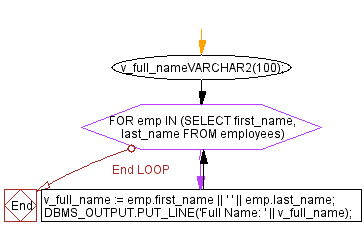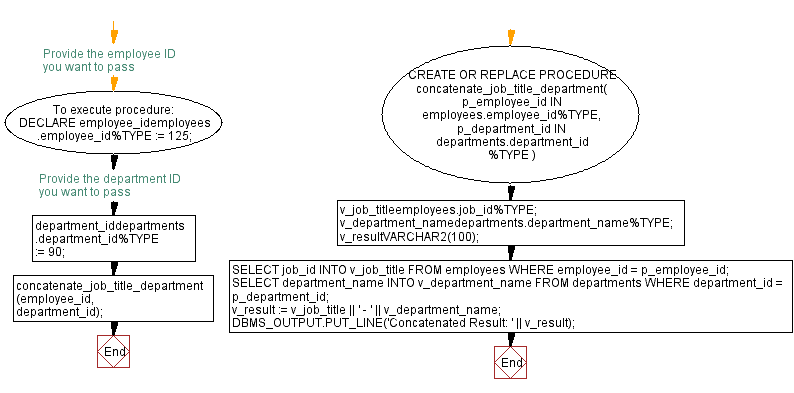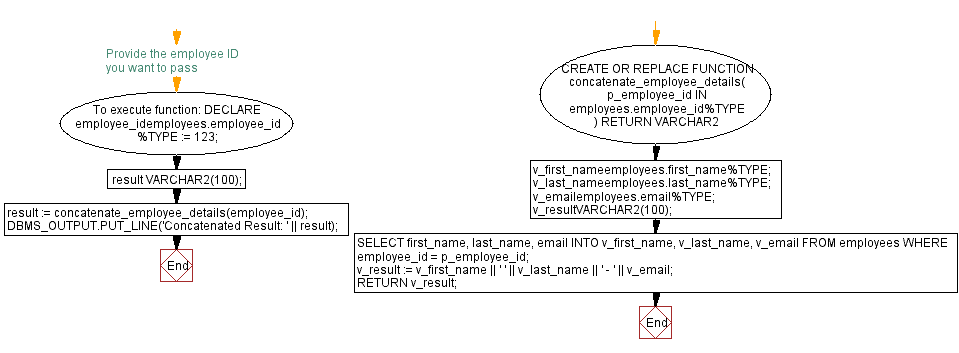CONCAT(): Oracle PL/SQL concatenation examples
PL/SQL String Functions: CONCAT()
Exercise 1:
Write a PL/SQL block to concatenate the first name and last name of each employee in the employees table and display the full name.
Sample Solution:
Table: employees
employee_id integer first_name varchar(25) last_name varchar(25) email archar(25) phone_number varchar(15) hire_date date job_id varchar(25) salary integer commission_pct decimal(5,2) manager_id integer department_id integer
PL/SQL Code:
DECLARE
v_full_nameVARCHAR2(100);
BEGIN
FOR emp IN (SELECT first_name, last_name FROM employees) LOOP
v_full_name := emp.first_name || ' ' || emp.last_name;
DBMS_OUTPUT.PUT_LINE('Full Name: ' || v_full_name);
END LOOP;
END;
/
Sample Output:
Full Name: Steven King Full Name: NeenaKochhar Full Name: Lex De Haan Full Name: Alexander Hunold Full Name: Bruce Ernst Full Name: David Austin Full Name: ValliPataballa Full Name: Diana Lorentz Full Name: Nancy Greenberg Full Name: Daniel Faviet Full Name: John Chen .....
Explanation:
The said code in Oracle's PL/SQL that retrieves data from the 'employees' table and concatenates the "first_name" and "last_name" columns to form a full name.
A variable v_full_name of VARCHAR2 type declares to store concatenated name of maximum length of 100 characters.
The FOR loop iterates over the result set obtained from the SELECT statement.
The SELECT statement retrieves the first_name and last_name columns from the employees table and store to loop variable emp.
Inside the loop, the first_name and last_name values are concatenated using the || operator and assigned to the v_full_name variable.
The DBMS_OUTPUT.PUT_LINE procedure prints the full name to the console along with the text 'Full Name: '.
Flowchart:

Exercise 2:
Create a PL/SQL procedure to concatenate the job title and department name for a specific employee identified by their employee ID and display the result.
Table: employees
employee_id integer first_name varchar(25) last_name varchar(25) email archar(25) phone_number varchar(15) hire_date date job_id varchar(25) salary integer commission_pct decimal(5,2) manager_id integer department_id integer
Table: departments
department_id integer department_name varchar(25) manager_id integer location_id integer
PL/SQL Code:
CREATE OR REPLACE PROCEDURE concatenate_job_title_department(
p_employee_id IN employees.employee_id%TYPE,
p_department_id IN departments.department_id%TYPE
) AS
v_job_titleemployees.job_id%TYPE;
v_department_namedepartments.department_name%TYPE;
v_resultVARCHAR2(100);
BEGIN
SELECT job_id INTO v_job_title FROM employees WHERE employee_id = p_employee_id;
SELECT department_name INTO v_department_name FROM departments WHERE department_id = p_department_id;
v_result := v_job_title || ' - ' || v_department_name;
DBMS_OUTPUT.PUT_LINE('Concatenated Result: ' || v_result);
END;
/
To execute procedure:
DECLARE
employee_idemployees.employee_id%TYPE := 125; -- Provide the employee ID you want to pass
department_iddepartments.department_id%TYPE := 90; -- Provide the department ID you want to pass
BEGIN
concatenate_job_title_department(employee_id, department_id);
END;
/
Sample Output:
Concatenated Result: ST_CLERK - Executive
Explanation:
The said code in Oracle's PL/SQL defines a procedure that concatenates the job title and department of an employee based on the given employee ID and department ID.
The procedure has two input parameters, the p_employee_id and the p_department_id .
The three variables v_job_title of employees job_id TYPE, v_department_name of departments department_name TYPE, and v_result of VARCHAR2 TYPE with a maximum length of 100 characters are declares.
The first SELECT statement retrieves the job ID from the employees table based on the specifies employee ID. The retrieved value is stored in the v_job_title variable.
The second SELECT statement retrieves the department name from the departments table based on the specified department ID. The retrieved value is stored in the v_department_name variable.
The v_result variable is assigned the concatenated value of v_job_title, a hyphen (' - '), and v_department_name.
The DBMS_OUTPUT.PUT_LINE procedure displays the concatenated result with the text 'Concatenated Result: ' to the console.
Flowchart:

Exercise 3:
Write a PL/SQL function to concatenate the first name, last name, and email of an employee identified by their employee ID and return the result.
Table: employees
employee_id integer first_name varchar(25) last_name varchar(25) email archar(25) phone_number varchar(15) hire_date date job_id varchar(25) salary integer commission_pct decimal(5,2) manager_id integer department_id integer
PL/SQL Code:
CREATE OR REPLACE FUNCTION concatenate_employee_details(
p_employee_id IN employees.employee_id%TYPE
) RETURN VARCHAR2 AS
v_first_nameemployees.first_name%TYPE;
v_last_nameemployees.last_name%TYPE;
v_emailemployees.email%TYPE;
v_resultVARCHAR2(100);
BEGIN
SELECT first_name, last_name, email INTO v_first_name, v_last_name, v_email
FROM employees WHERE employee_id = p_employee_id;
v_result := v_first_name || ' ' || v_last_name || ' - ' || v_email;
RETURN v_result;
END;
/
To execute function:
DECLARE
employee_idemployees.employee_id%TYPE := 123; -- Provide the employee ID you want to pass
result VARCHAR2(100);
BEGIN
result := concatenate_employee_details(employee_id);
DBMS_OUTPUT.PUT_LINE('Concatenated Result: ' || result);
END;
/
Sample Output:
Concatenated Result: Julia Nayer - JNAYER
Explanation:
The said code in Oracle's PL/SQL defines a function that concatenates the first name, last name, and email of an employee based on the specified employee ID.
The takes an input parameter p_employee_id of type employee_id of employees table and it specifies the employee for which the details will be concatenated.
The four variables v_first_name of type first_name, v_last_name of type last_name, and v_email of type email of the table employees, and v_result of type VARCHAR2 with a maximum length of 100 characters are declares.
The SELECT statement retrieves the first name, last name, and email from the employees table based on the specified employee ID and stored in the variables v_first_name, v_last_name, and v_email.
The v_result variable is assigned the concatenated value of v_first_name, a space ,v_last_name,a hyphen (' - '), and v_email.
The RETURN statement is used to return the value of v_result from the function.
Flowchart:

Go to:
PREV : LENGTH() Functions.
NEXT : INSTR() Function.
Improve this sample solution and post your code through Disqus
What is the difficulty level of this exercise?
